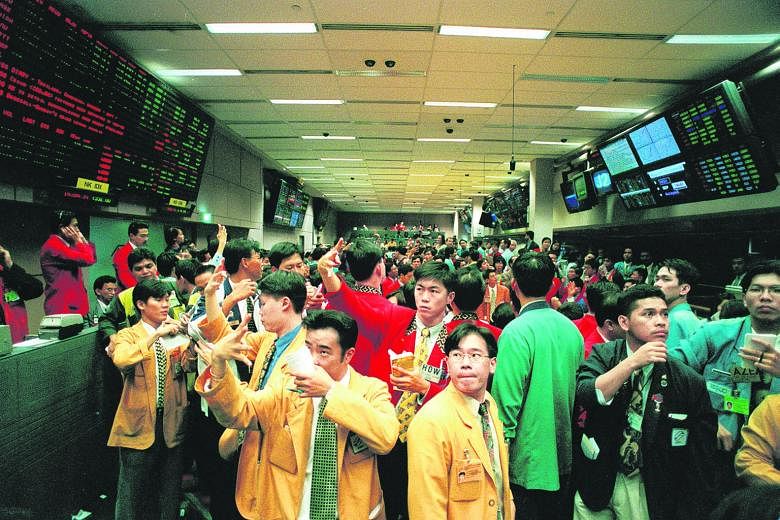2008
The sub-prime crisis in the United States in 2008 triggered a global financial meltdown. As a trade-oriented nation with little domestic demand to cushion the economy, Singapore was the first East Asian economy to slip into recession, its worst since independence.
"I wake up each morning to more bad news in the United States and go to work amid a furious selldown in Singapore and the rest of Asia," ST's managing editor, then its Money editor, Ignatius Low, wrote in a commentary on Oct 11, 2008.
"At dinner time, I glance up nervously at the television to check which European bank has failed now and which government has had to guarantee deposits. Nights are spent watching the opening bell ring in the US markets, silently willing them to (please) go up. Everything I learnt in school and since I started work is being turned on its head. Let markets be free, proclaimed the greatest economic thinkers, and keep government intervention to a minimum.
"What is clear to me is that we will emerge from the crisis with many paradigms shifted."
As it did during the 1930s Great Depression, The Straits Times kept its focus on the road to recovery. The newspaper urged companies to reconsider laying off workers, arguing that preparing for the post-recession demand would place businesses in a better position for the future.
-
 1930
1930GREAT DEPRESSION
The Straits Times' first resident correspondent, George Peet (above), is posted to Kuala Lumpur.
The Great Depression hits the prices of rubber and tin in Malaya and brings the economy to a standstill. The Straits Times urges companies to "extend their activities" and for the government to maintain public expenditure to save jobs and help recovery. Editor George Seabridge criticises the government for its austerity plan of trimming salaries and axing jobs.
 The Straits Times sets an example by expanding and spending its way out of the slump - it buys a fleet of Morris Minor vans to deliver the paper upcountry, invests in state-of-the-art new printing machinery and constructs a new office.
The Straits Times sets an example by expanding and spending its way out of the slump - it buys a fleet of Morris Minor vans to deliver the paper upcountry, invests in state-of-the-art new printing machinery and constructs a new office.The Straits Times offers free advertising to unemployed people seeking jobs. It runs a column, labelled Victims Of The Slump, that reveals the growing levels of desperation among planters, miners and commercial assistants during this tough period.
Seabridge extends the distribution of The Straits Times to Kuala Lumpur and Penang.
"The crisis will not be short-lived but it will, in time, subside," said The Straits Times editorial on Oct 11, 2008. "So while cost-cutting is going to be necessary, companies need to appreciate that any over-reaction might well handicap them when the demand picks up again."
The newspaper also supported tapping into Singapore's reserves to temporarily finance government programmes to minimise layoffs.
In a Jan 23, 2009 editorial, The Straits Times praised the 2009 Budget, particularly for its "strong element of social responsibility" noting that the "key to navigating the recession safely is that paid employment does not collapse".
The wider anxieties thrown up by the recession also made headlines. Losses made by Singapore's investment company Temasek Holdings sparked a public outcry and a call for it to be more open about major investment decisions.
In an analysis published on Nov 1, 2008, The Straits Times observed that the worst financial crisis in living memory had precipitated new political implications and increased citizen activism. It also weakened trust in established institutions and led to calls for stronger employment and social safety nets.
There was also heightened doubt about the risks involved in high-profile and capital-intensive projects, such as the integrated resorts, which were prone to global volatility and regional competition while being dependent on foreign capital and skills.
Against these downsides, there was also a renewed appreciation for the Government's prudent and conservative yet compassionate fiscal policies, such as safeguards preventing excessive speculation in financial and property markets and jobs schemes designed to encourage employers to retain their workers.
By mid-2009, another scary economic episode in Singapore's history had been successfully navigated.
If there are any lasting lessons to draw from grappling with a downturn as steep as the 2008 recession or as deep as the 1930s Great Depression, the most useful is probably that there is no inoculation available.
Economists and governments continue to chase their version of the holy grail - how to create solid, steady growth, with no booms and no busts. It remains elusive. The Straits Times, meanwhile, will continue to do what it has been doing: spotting trends, cultivating broad economic literacy among readers, always urging and acting with the continued success of Singapore and its people at heart. • ST



